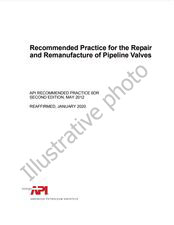We need your consent to use the individual data so that you can see information about your interests, among other things. Click "OK" to give your consent.

API RP 2RIM-ed.1
Integrity Management of Risers from Floating Production Systems
Translate name
STANDARD published on 1.9.2019
The information about the standard:
Designation standards: API RP 2RIM-ed.1
Publication date standards: 1.9.2019
SKU: NS-1140097
The number of pages: 72
Approximate weight : 216 g (0.48 lbs)
Country: American technical standard
Category: Technical standards API
Annotation of standard text API RP 2RIM-ed.1 :
API RP 2RIM, 1st Edition, September 2019 - Integrity Management of Risers from Floating Production Systems
This recommended practice (RP) provides guidance for the integrity management (IM) of risers connected to a permanent floating production system (FPS) used for the drilling, development, production, and storage of hydrocarbons in offshore areas.
A riser is typically part of a larger subsea system extending from a wellhead, tree, manifold, template, or other structure on the seabed, to a boarding valve or pig trap on the host platform’s topsides. This RP addresses the integrity management of the dynamic portion of the riser system.
For the purposes of this RP, a riser has a top boundary that is somewhere at or above the point where it transfers load to the platform structure, and it has a lower boundary where it transfers load into a foundation, which could be a wellhead, pipeline, or subsea structure.
For a top-tensioned riser (TTR), the top boundary would typically be the tensioner system hang-off point, and the bottom boundary would be the wellhead. For a steel catenary riser (SCR), the top boundary would typically be the stress joint or flexible joint. Some unusual configurations such as pull-tube SCRs merit special consideration. The top boundaries of a flexible or hybrid riser are typically a flanged connection to the riser end fitting at the top of an I-tube or J-tube, and a bend stiffener at the bottom of a I-tube or J-tube.
The IM of the structural support for a riser on the host platform is in the scope of API 2FSIM, although some hybrid configurations, such as pull tubes, can require overlapping riser and structural IM.
For risers structurally connected to the platform below the topsides, hull piping can be structurally clamped to the hull up to a boarding valve or pig launcher at the topsides. This is intended to be considered as part of the riser in terms of IM, although it also has structural elements addressed in API 2FSIM.
The scope of this RP includes:
- — structural components of the riser;
- — riser top hang-off assembly (i.e. stress joint, flexible joint, tensioner system/air can, bend stiffener);
- — appurtenances attached to the riser that are critical to its integrity, including VIV suppression devices and buoyancy modules used to support the riser in any capacity;
- — corrosion protection systems;
- — insulation;
- — other components in the load path or supporting the riser.
The scope of this RP specifically does not include:
- — structural support for the riser on the host platform (i.e. riser porch, pull tube, tensioner support structure);
- — wellhead or subsea structure at the lower end of the riser;
- — valves (other than the mechanical design if they are in the dynamic load path);
- — risers connected to mobile offshore drilling units (MODUs) or fixed platforms.
NOTE However, the interface of the riser with these components is important to the IM of the riser system.
Specific recommendations are provided for the inspection, monitoring, evaluation of damage, fitness-for-service assessment, risk reduction, mitigation planning, and decommissioning of risers. This RP incorporates and expands on the integrity management recommendations found in API 2RD, API 17B, and API 17L2.
We recommend:
Technical standards updating
Do you want to make sure you use only the valid technical standards?
We can offer you a solution which will provide you a monthly overview concerning the updating of standards which you use.
Would you like to know more? Look at this page.



 Cookies
Cookies
